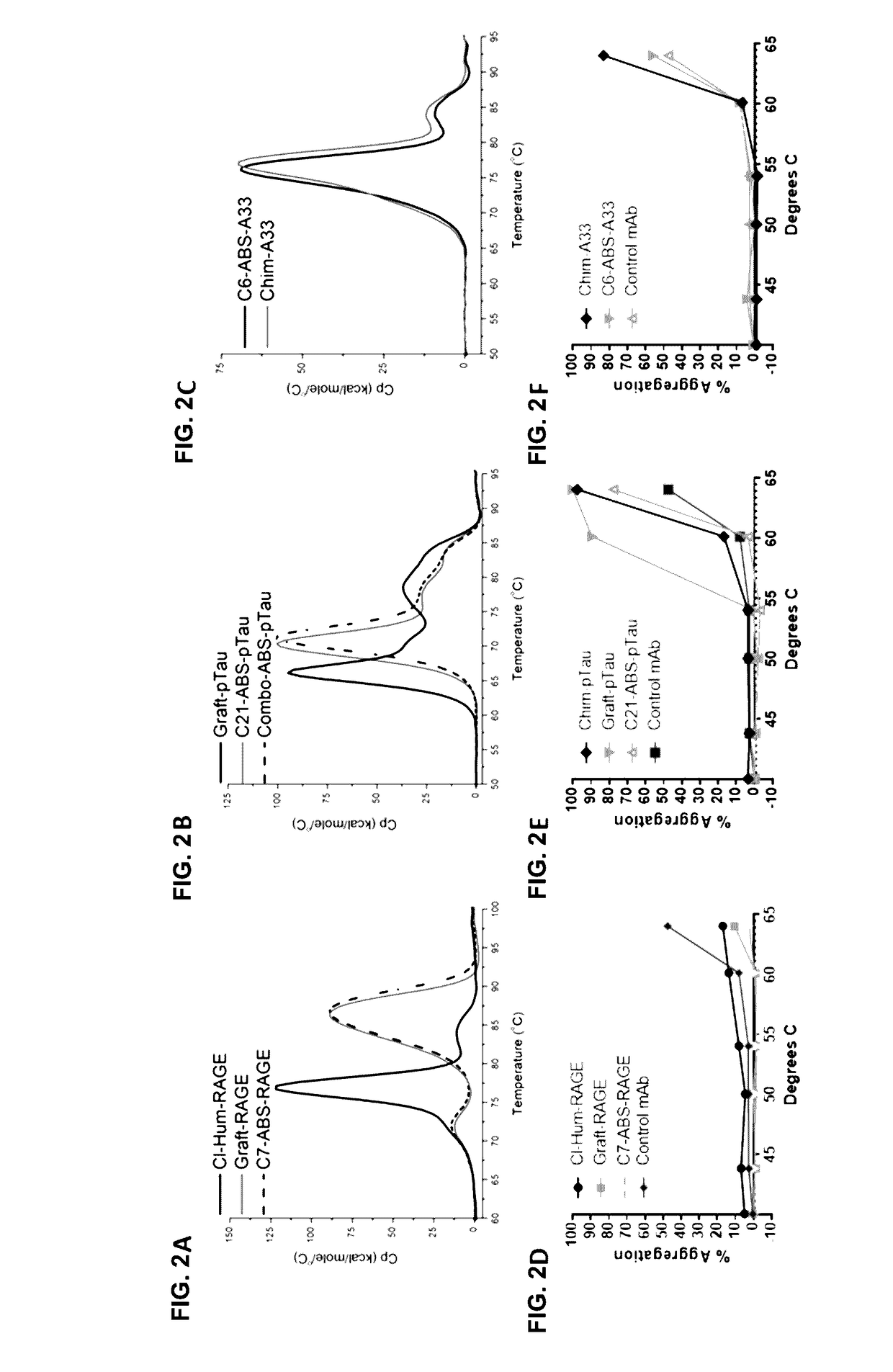Humanized antibodies
a technology of humanized antibodies and antibodies, applied in the field of humanized antibodies, can solve the problems of high non-human amino acid content retention, inability to fully humanize, and often severely impaired affinity
- Summary
- Abstract
- Description
- Claims
- Application Information
AI Technical Summary
Benefits of technology
Problems solved by technology
Method used
Image
Examples
example 1
Library Design, Build and Characterization
[0190]Rat anti-RAGE XT-M4, rabbit anti-A33, and chicken anti-pTau pT231 / pS235_1 IgGs were generated on the human IgG1 backbone with either parental (Par-RAGE, Par-A33 or Par-pTau), grafted (Graft-RAGE, Graft-A33 or Graft-pTau), or classically humanized (CL-Hum-RAGE, CL-Hum-A33) v-domains. In scFv format, the parental form of each of these antibodies retained antigen binding, while the human FW-grafted versions demonstrated little to no binding (FIGS. 5A-5C). ABS ultra-humanization libraries (ABS-RAGE, ABS-A33, ABS-pTau) were constructed (FIG. 1) to generate 1.8×109 independent clones for ABS-RAGE, 1.1×1010 for ABS-A33 and 4.9×109 for ABS-pTau (theoretical binary diversity for ABS-RAGE is 227 positions=1.34×108, for ABS-A33 232=4.29×109 and for ABS-pTau 233=8.59×109).
[0191]The quality of pTau library build was verified by sequence analyses of ≧96 clones / library. After library transformation, the full scFv insert sequences were obtained for 96...
example 2
Identification and Analysis of Ultra-Humanized Clones
[0192]Clone selection in ABS library screening (pTau example) was conducted. Periprep ELISA was conducted to screen for single clones picked from multiple rounds of phage display selections of the ABS-pTau library. One hundred and eighty-eight clones were prioritized on the basis of retention of binding to the pT231_pS253 phosphopeptide, with A450 readings above the negative control (Anti-RAGE scFv), and equivalent to or above that of Par-pTau scFv. Periprep HTRF was conducted to screen these 188 single clones for epitope competition with wild-type IgG. Clones were prioritized on the basis of neutralisation of Par-pTau IgG binding to the pT231_pS253 phosphopeptide, with % ΔF readings lower than the negative control (Anti-RAGE scFv) and equivalent to or better that of Par-pTau scFv.
[0193]Post-selection screening revealed the presence of numerous scFv clones with significantly increased human content within the CDRs. In the ABS-RAGE...
example 3
Lead IgG Affinity, Stability and Specificity Characteristics
[0194]ABS leads in human IgG1 format were analyzed for specificity and stability. HTRF data (FIGS. 7A-7C), showed that the lead ABS-derived IgGs had successfully maintained full epitope competition with their respective parental clones (Table 1). Biacore analyses showed approximately 2-fold affinity improvements for C7-ABS-RAGE and C21-ABS-pTau over Par-RAGE and Par-pTau, respectively, while C2-ABS-A33 maintained equivalent affinity to Par-A33 (Table 1).
[0195]A baculovirus ELISA assay (FIG. 8A) has been reported in antibody polyreactivity screening as a risk indicator for poor pK in vivo. In this assay, no reactivity was observed for any of the RAGE, A33 or pTau clones in comparison to an internal positive control antibody. For the anti-RAGE and anti-A33 antibodies, a high-sensitivity Biacore assay was also established, to examine the possibility that v-gene engineering might lead to low affinity interactions with multiple ...
PUM
| Property | Measurement | Unit |
|---|---|---|
| Ka | aaaaa | aaaaa |
| Tm | aaaaa | aaaaa |
| Tm | aaaaa | aaaaa |
Abstract
Description
Claims
Application Information
 Login to View More
Login to View More - R&D
- Intellectual Property
- Life Sciences
- Materials
- Tech Scout
- Unparalleled Data Quality
- Higher Quality Content
- 60% Fewer Hallucinations
Browse by: Latest US Patents, China's latest patents, Technical Efficacy Thesaurus, Application Domain, Technology Topic, Popular Technical Reports.
© 2025 PatSnap. All rights reserved.Legal|Privacy policy|Modern Slavery Act Transparency Statement|Sitemap|About US| Contact US: help@patsnap.com



